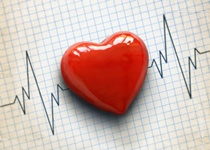 Want to know a scary truth? Think about three people you know—maybe they’re friends, co-workers, or family members living under the same roof as you. Now consider that there is a very real chance that at least one of you will die from heart disease. Clearly, this disease is serious and it’s one that I want you to know more about.
Want to know a scary truth? Think about three people you know—maybe they’re friends, co-workers, or family members living under the same roof as you. Now consider that there is a very real chance that at least one of you will die from heart disease. Clearly, this disease is serious and it’s one that I want you to know more about.
To start, heart disease kills one in four Americans, so it might be shocking to hear that prevention is not a big priority for most. In fact, only three percent of American adults practice the “big four” habits of heart disease prevention: eating a healthy diet, participating in regular physical activity, maintaining a healthy weight, and staying away from smoking. Strange to think that someone would do so little to fend off a major killer that is largely preventable. In essence, heart disease doesn’t come get you; through your lifestyle choices, you get it.
For some reason, people take their hearts for granted. For example, a recent survey in the UK indicated that a third of its participants were concerned about getting dementia or cancer, while only two percent were concerned about heart disease, even though it’s far more likely to kill them. What’s scary is that most people don’t even know the warning signs of heart disease.
Heart disease kills 600,000 Americans and 380,000 of those deaths are from coronary heart disease. The symptoms, like lightheadedness, regular aches and pains, and acid reflux, are often overlooked as stress-related or part of aging.
Furthermore, men experience different symptoms than women. Men tend to experience the more traditional chest pain that you see in the movies, whereas women don’t. Their symptoms might appear as back pain or acid reflux, or it may feel like normal stress. And some people don’t experience symptoms at all, making coronary heart disease the “silent killer.”
You’re increasing your risk for coronary heart disease and heart attack if you smoke, have a poor diet, don’t get regular exercise, eat a lot of salt, are overweight, or drink a lot of alcohol.
So what can you do to protect yourself from heart disease? Well, you should start by making regular trips to the doctor to check the health of your heart. Some other simple preventative measures you can take include:
– Quitting smoking
– Maintaining a healthy weight
– Increasing physical activity
– Limiting salt intake
– Eating at least five servings of fruits and vegetables per day
– Cutting back on saturated fat
– Reading food labels to make better nutrition choices
– Watching portion sizes
– Limiting your alcohol intake
The truth is that you don’t have to be the one in four who dies from heart disease if you don’t want to be. It’s an entirely preventable condition; you just have to take the initiative to protect your health.
Sources for Today’s Article:
Briggs, H., “Heart disease warning factors ‘missed by many adults,’” BBC web site, September 28, 2014; http://www.bbc.com/news/health-29381914.
“Heart Attack Symptoms in Women,” American Heart Association web site, October 20, 2012; http://www.heart.org/HEARTORG/Conditions/HeartAttack/WarningSignsofaHeartAttack/Heart-Attack-Symptoms-in-Women_UCM_436448_Article.jsp, last accessed October 1, 2014.
“Heart Disease Facts,” Centers for Disease Control and Prevention web site, September 26, 2014; http://www.cdc.gov/heartdisease/facts.htm.
“Your Guide to a Healthy Heart,” National Heart, Lung, and Blood Institute web site; http://www.nhlbi.nih.gov/health/resources/heart/healthy-heart-guide-html.htm, last accessed October 1, 2014.
